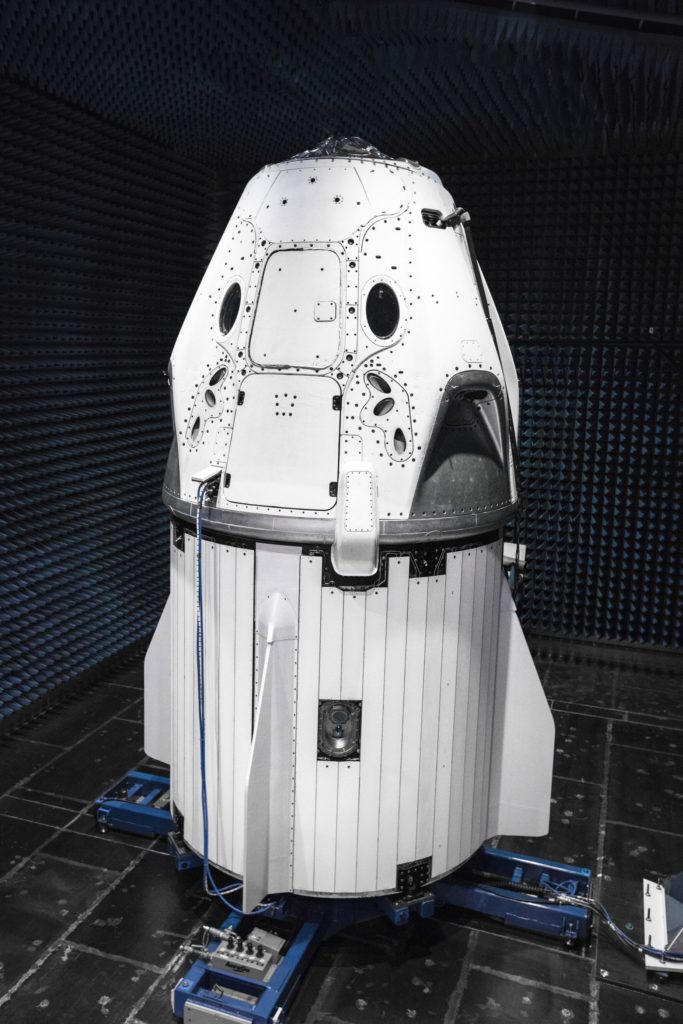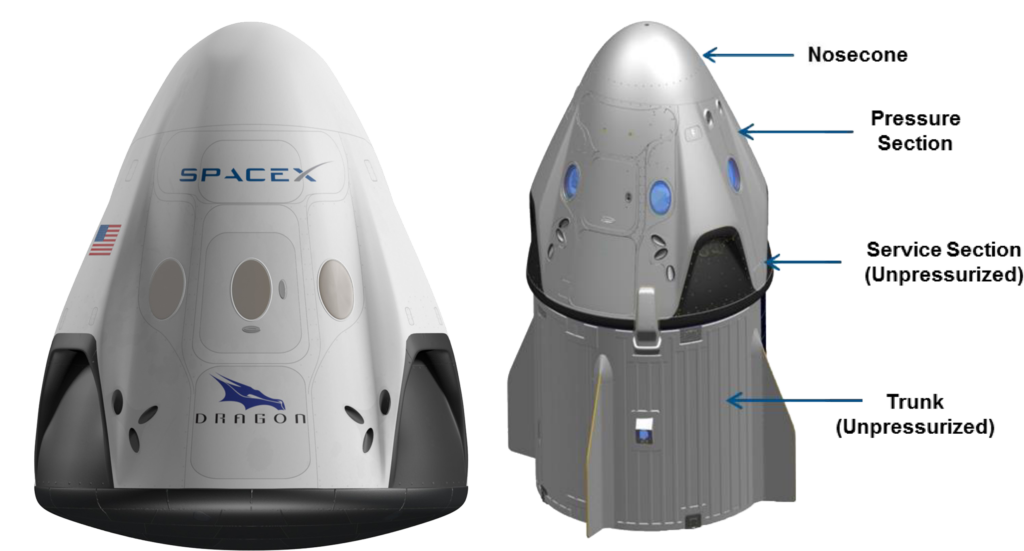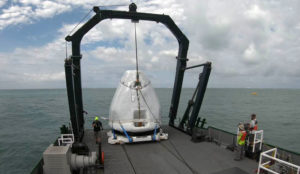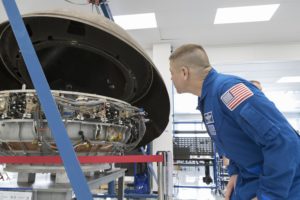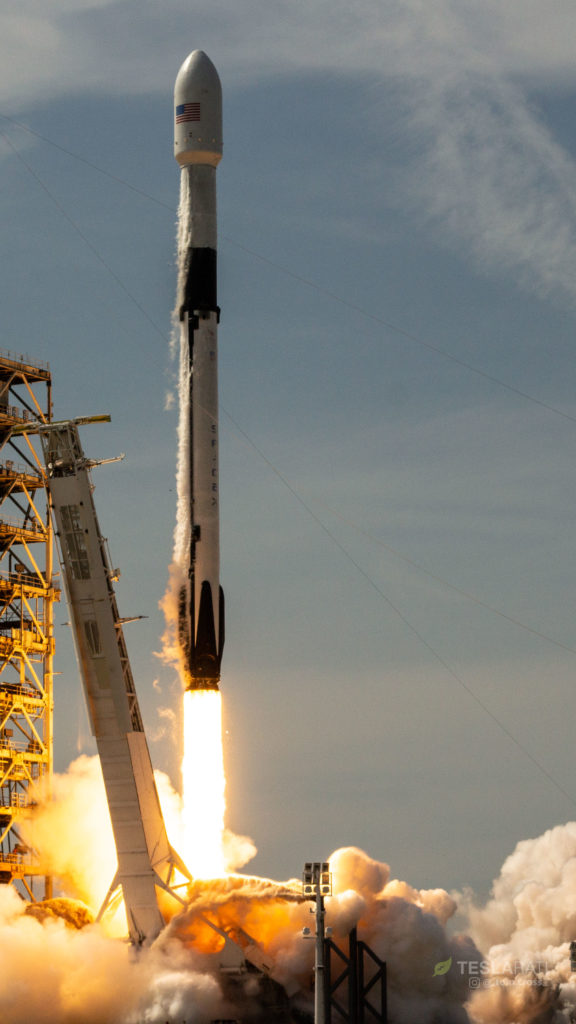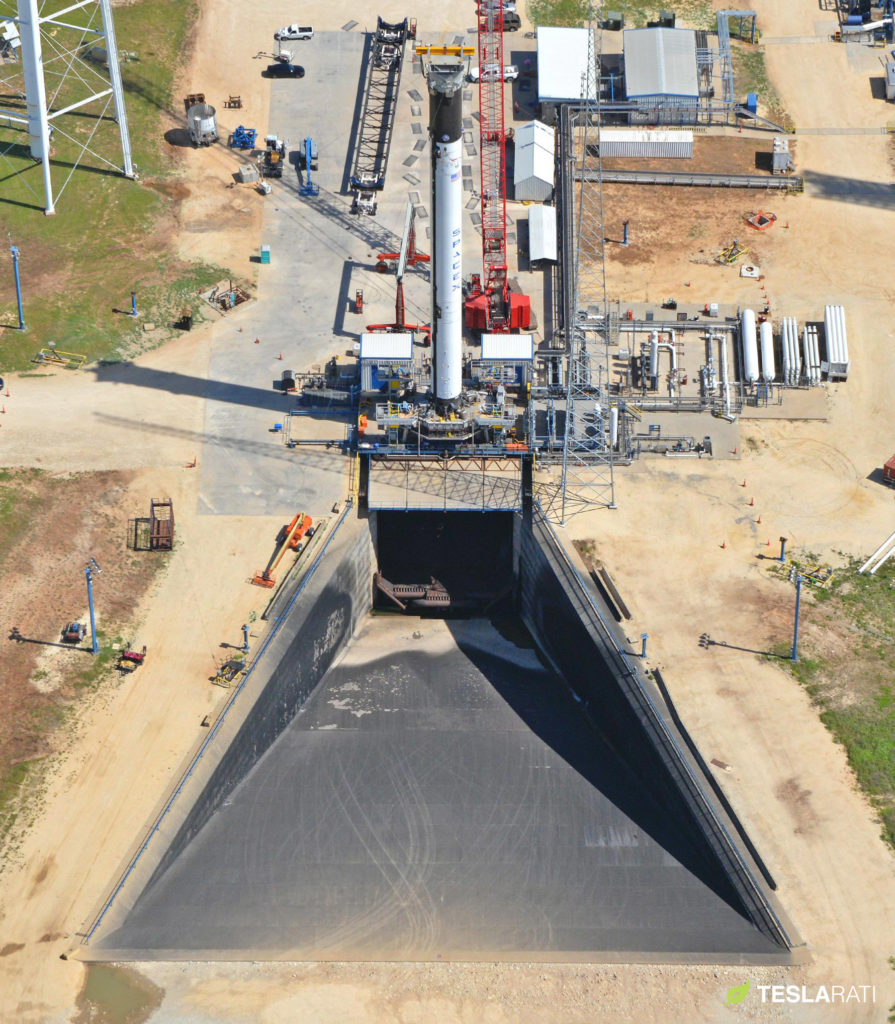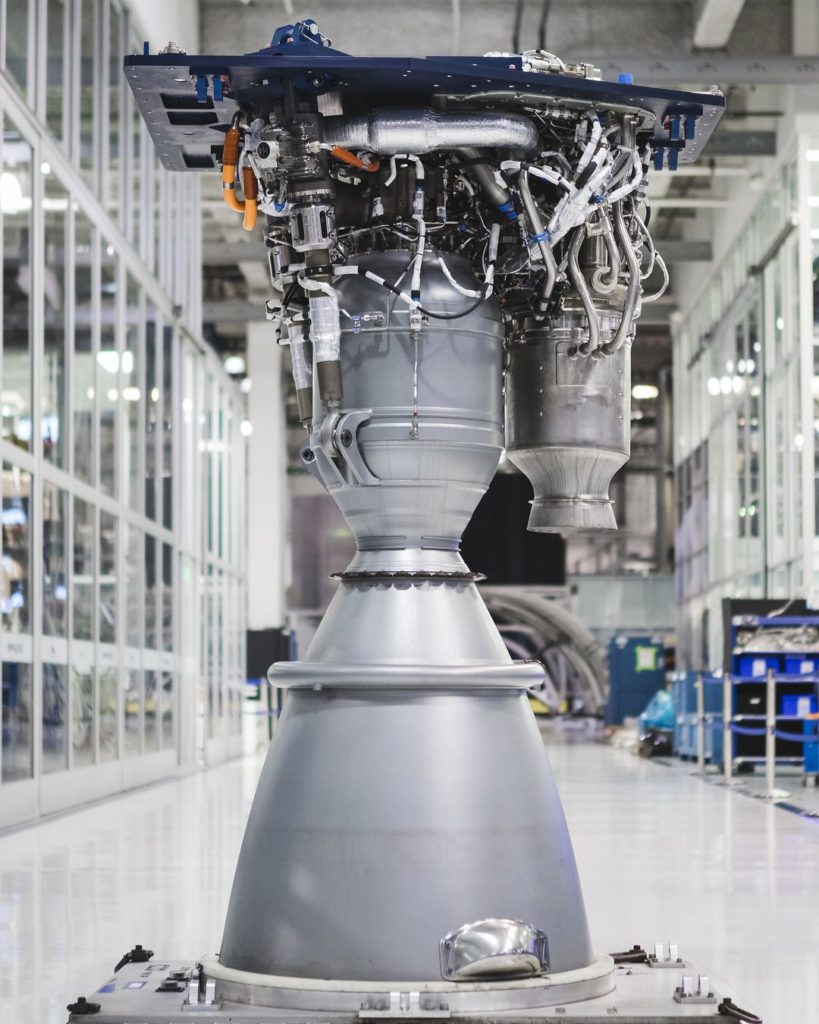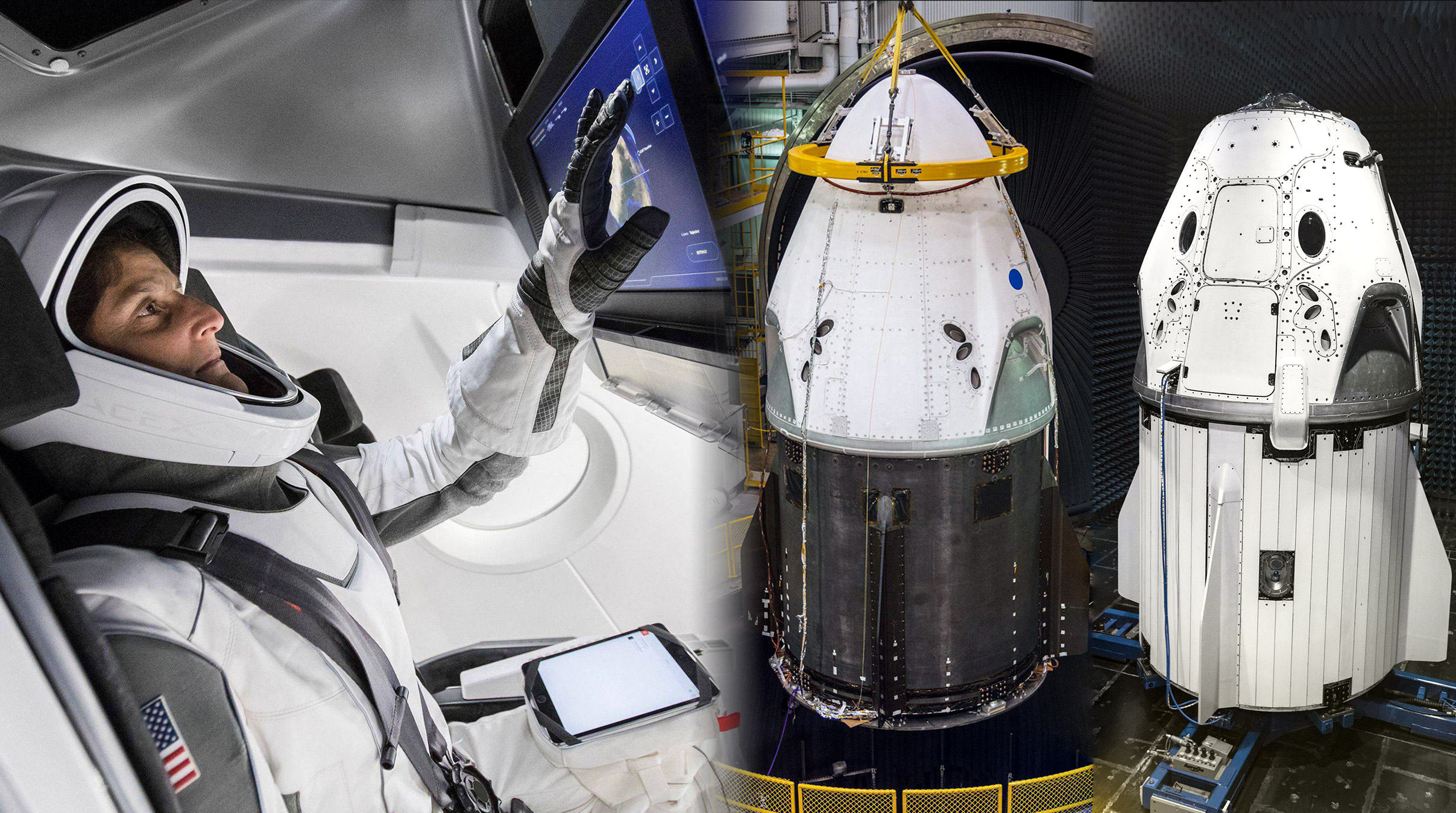
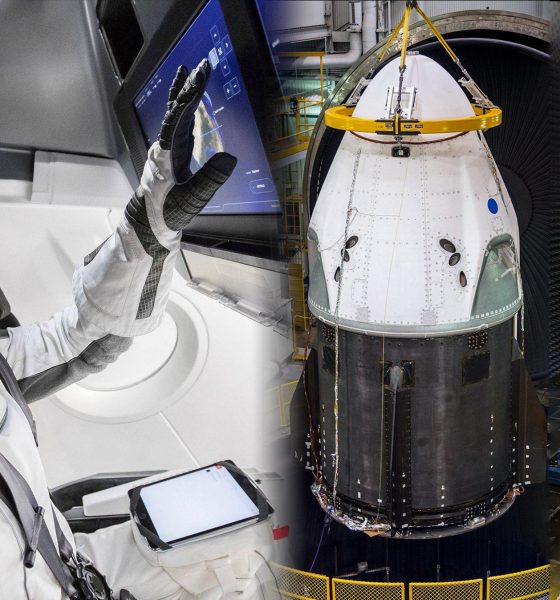
News
SpaceX’s Crew Dragon spaceship marches towards launch with vacuum chamber test
SpaceX has published the latest photo of its next-generation Crew Dragon spacecraft, showing the crewed vehicle preparing to be put through its paces inside a NASA thermal vacuum chamber located in Cleveland, Ohio. If the tests are completed without issue, the Dragon’s next destination will be Cape Canaveral, Florida, where it will prepare for an inaugural launch targeted for the fourth quarter of 2018.
In the photo released on June 20th, SpaceX’s DM-1 Crew Dragon capsule (C202 in shorthand: [C]apsule, Dragon [2], serial number [02]) is seen being craned by SpaceX technicians into the thermal vacuum chamber at NASA’s Plum Brook testing facilities. Located in Ohio, Plum Brook’s vacuum chamber is unique because of both its size and its ability to fairly accurate replicate the actual environment faced by satellites and spacecraft once in space. Most importantly, this includes the extreme thermal conditions those vehicles are subjected to by constant ~90-minute day-night cycles in low Earth orbit (LEO).
Without Earth’s cozy atmosphere to act as both a heat sink and insulating blanket once on orbit, there is simply nothing there to protect spacecraft like Crew Dragon from the absolute extremes of direct solar radiation (sunlight), total darkness, and a complete lack of cooling by conduction and convection. In order to avoid overheating, Crew Dragon thus needs to bring along its own means of cooling in the form of onboard radiators to shed excess heat. The use of white paint on spacecraft further aids this process by selectively preventing the absorption of solar radiation while simultaneously efficiently emitting in infrared wavelengths.
- SpaceX’s Demo Mission-1 Crew Dragon seen preparing for vacuum tests at a NASA-run facility, June 2018. (SpaceX)
- The DM-1 Crew Dragon testing inside SpaceX’s anechoic chamber, May 2018. (SpaceX)
- An overview of Crew Dragon’s main features, all of which can be seen in the real-life photos. The Cargo Dragon version will likely remove seats and windows. (SpaceX)
How to prep your Dragon
Crew Dragon’s primary radiators are elegantly integrated into vertical panels installed on the cylindrical bottom segment, known as the trunk, while the craft’s power source – solar panels in this case – are installed in a curved array on the opposite side of the trunk. Intriguingly, the trunks displayed in the two most recent photos of the DM-1 Crew Dragon appear to be almost completely different, and the trunk at Plum Brook does not appear to have its solar arrays or radiators installed. Nominally, SpaceX would use the thermal vacuum capabilities of the Ohio facility to fully vet Crew Dragon’s ability to maintain optimal temperatures on orbit, but the particularly tests planned for the DM-1 capsule and trunk may be of a slightly different type.
- On February 28, SpaceX completed a demonstration of their ability to recover the crew and capsule after a nominal water splashdown in the Atlantic Ocean, just off the coast of Florida. (SpaceX)
- Astronaut Bob Behnken examines a sample of Crew Dragon docking and crew transfer hardware, the mechanisms that will allow the spacecraft to dock with the International Space Station and allow crew to enter the orbital outpost. Taken March 2017. (SpaceX)
Regardless, after testing at Plum Brook is completed, the DM-1 Crew Dragon capsule will be shipped to a newly-constructed processing facility in Cape Canaveral, Florida, while it’s understood that the trunk installed in SpaceX’s June 20th photo will be returned to the Hawthorne, CA factory to be outfitted with flight hardware (presumably including cameras, radiators, solar arrays, and a healthy amount of insulation). It’s unclear when the two segments of DM-1 will part ways and head on to their next destinations, but it’s likely that testing at Plum Brook will last for at least a handful of weeks.
Birds of a feather
In the meantime, several additional Crew Dragon capsules/trunks and the Falcon 9 Block 5 rockets that will launch them are in a variety of states of fabrication and assembly at SpaceX’s Hawthorne factory. B1051, the Block 5 booster assigned to the first uncrewed Demo-1 launch of Crew Dragon, was reported by NASA to be undergoing propellant tank integration in March 2018, implying that the rocket should be at or near the final stages of integration, and will likely ship to McGregor, Texas for static fire testing late this summer.
As of June 15th, SpaceX’s third Falcon 9 Block 5 booster was vertical on the Texas test stand, likely nearing its own static fire test before being shipped to SpaceX’s Vandenberg Air Force Base launch facilities for the July 20th launch of Iridium-7. While possible that a booster slipped past the watchful eyes and ears of SpaceX enthusiast observers, it’s probable that the rocket currently in McGregor is B1048, implying that a minimum of two additional booster shipments and Texas test programs remain before B1051 can be prepped to launch SpaceX’s first Crew Dragon mission. At the current marginally accelerated booster production and shipment schedule (~ 30-day cadence), B1051 would be expected to leave Hawthorne for Texas no earlier than (NET) late August or early September. This meshes with a recent comment from Commercial Crew astronaut Suni Williams:
“I think we’re going to get the [uncrewed[ demo flights probably by the end of the year, maybe a little after that . . . and then the crew demo missions next year.”
- Falcon 9 Block 5 completed its first launch on May 11, carrying the Bangabandhu-1 communications satellite to geostationary transfer orbit. (Tom Cross)
- SpaceX’s second Block 5 booster was spotted vertical at the company’s McGregor, TX testing facilities. That booster has since been shipped to Florida for a mid-July launch, with B1048 now in its place as of June 15. (Aero Photo)
- A matte-silver Block 5 Merlin 1D rocket engine seen preparing to leave SpaceX’s Hawthorne factory for testing in Texas. (SpaceX)
Anticipating acceptance and prelaunch testing that is far more extensive and time-consuming than typically seen with SpaceX’s commercial missions, it’s safe to bet that the first uncrewed Crew Dragon mission – DM-1 – will launch from Kennedy Space Center in November or December 2018. While those operations proceed over the course of the rest of this year, SpaceX expects roughly 10 additional Falcon 9 and Falcon Heavy launches to occur. It’s gonna be a busy H2.
Follow us for live updates, peeks behind the scenes, and photos from Teslarati’s East and West Coast photographers.
Teslarati – Instagram – Twitter
Tom Cross – Twitter
Pauline Acalin – Twitter
Eric Ralph – Twitter

Elon Musk
Elon Musk’s X will start using a Tesla-like software update strategy
The initiative seems designed to accelerate updates to the social media platform, while maintaining maximum transparency.

Elon Musk’s social media platform X will adopt a Tesla-esque approach to software updates for its algorithm.
The initiative seems designed to accelerate updates to the social media platform, while maintaining maximum transparency.
X’s updates to its updates
As per Musk in a post on X, the social media company will be making a new algorithm to determine what organic and advertising posts are recommended to users. These updates would then be repeated every four weeks.
“We will make the new 𝕏 algorithm, including all code used to determine what organic and advertising posts are recommended to users, open source in 7 days. This will be repeated every 4 weeks, with comprehensive developer notes, to help you understand what changed,” Musk wrote in his post.
The initiative somewhat mirrors Tesla’s over-the-air update model, where vehicle software is regularly refined and pushed to users with detailed release notes. This should allow users to better understand the details of X’s every update and foster a healthy feedback loop for the social media platform.
xAI and X
X, formerly Twitter, has been acquired by Elon Musk’s artificial intelligence startup, xAI last year. Since then, xAI has seen a rapid rise in valuation. Following the company’s the company’s upsized $20 billion Series E funding round, estimates now suggest that xAI is worth tens about $230 to $235 billion. That’s several times larger than Tesla when Elon Musk received his controversial 2018 CEO Performance Award.
As per xAI, the Series E funding round attracted a diverse group of investors, including Valor Equity Partners, Stepstone Group, Fidelity Management & Research Company, Qatar Investment Authority, MGX, and Baron Capital Group, among others. Strategic partners NVIDIA and Cisco Investments also continued support for building the world’s largest GPU clusters.
News
Tesla FSD Supervised wins MotorTrend’s Best Driver Assistance Award
The decision marks a notable reversal for the publication from prior years, with judges citing major real-world improvements that pushed Tesla’s latest FSD software ahead of every competing ADAS system.

Tesla’s Full Self-Driving (Supervised) system has been named the best driver-assistance technology on the market, earning top honors at the 2026 MotorTrend Best Tech Awards.
The decision marks a notable reversal for the publication from prior years, with judges citing major real-world improvements that pushed Tesla’s latest FSD software ahead of every competing ADAS system. And it wasn’t even close.
MotorTrend reverses course
MotorTrend awarded Tesla FSD (Supervised) its 2026 Best Tech Driver Assistance title after extensive testing of the latest v14 software. The publication acknowledged that it had previously criticized earlier versions of FSD for erratic behavior and near-miss incidents, ultimately favoring rivals such as GM’s Super Cruise in earlier evaluations.
According to MotorTrend, the newest iteration of FSD resolved many of those shortcomings. Testers said v14 showed far smoother behavior in complex urban scenarios, including unprotected left turns, traffic circles, emergency vehicles, and dense city streets. While the system still requires constant driver supervision, judges concluded that no other advanced driver-assistance system currently matches its breadth of capability.
Unlike rival systems that rely on combinations of cameras, radar, lidar, and mapped highways, Tesla’s FSD operates using a camera-only approach and is capable of driving on city streets, rural roads, and freeways. MotorTrend stated that pure utility, the ability to handle nearly all road types, ultimately separated FSD from competitors like Ford BlueCruise, GM Super Cruise, and BMW’s Highway Assistant.
High cost and high capability
MotorTrend also addressed FSD’s pricing, which remains significantly higher than rival systems. Tesla currently charges $8,000 for a one-time purchase or $99 per month for a subscription, compared with far lower upfront and subscription costs from other automakers. The publication noted that the premium is justified given FSD’s unmatched scope and continuous software evolution.
Safety remained a central focus of the evaluation. While testers reported collision-free operation over thousands of miles, they noted ongoing concerns around FSD’s configurable driving modes, including options that allow aggressive driving and speeds beyond posted limits. MotorTrend emphasized that, like all Level 2 systems, FSD still depends on a fully attentive human driver at all times.
Despite those caveats, the publication concluded that Tesla’s rapid software progress fundamentally reshaped the competitive landscape. For drivers seeking the most capable hands-on driver-assistance system available today, MotorTrend concluded Tesla FSD (Supervised) now stands alone at the top.
News
Elon Musk’s Grokipedia surges to 5.6M articles, almost 79% of English Wikipedia
The explosive growth marks a major milestone for the AI-powered online encyclopedia, which was launched by Elon Musk’s xAI just months ago.

Elon Musk’s Grokipedia has grown to an impressive 5,615,201 articles as of today, closing in on 79% of the English Wikipedia’s current total of 7,119,376 articles.
The explosive growth marks a major milestone for the AI-powered online encyclopedia, which was launched by Elon Musk’s xAI just months ago. Needless to say, it would only be a matter of time before Grokipedia exceeds English Wikipedia in sheer volume.
Grokipedia’s rapid growth
xAI’s vision for Grokipedia emphasizes neutrality, while Grok’s reasoning capabilities allow for fast drafting and fact-checking. When Elon Musk announced the initiative in late September 2025, he noted that Grokipedia would be an improvement to Wikipedia because it would be designed to avoid bias.
At the time, Musk noted that Grokipedia “is a necessary step towards the xAI goal of understanding the Universe.”
Grokipedia was launched in late October, and while xAI was careful to list it only as Version 0.1 at the time, the online encyclopedia immediately earned praise. Wikipedia co-founder Larry Sanger highlighted the project’s innovative approach, noting how it leverages AI to fill knowledge gaps and enable rapid updates. Netizens also observed how Grokipedia tends to present articles in a more objective manner compared to Wikipedia, which is edited by humans.
Elon Musk’s ambitious plans
With 5,615,201 total articles, Grokipedia has now grown to almost 79% of English Wikipedia’s article base. This is incredibly quick, though Grokipedia remains text-only for now. xAI, for its part, has now updated the online encyclopedia’s iteration to v0.2.
Elon Musk has shared bold ideas for Grokipedia, including sending a record of the entire knowledge base to space as part of xAI’s mission to preserve and expand human understanding. At some point, Musk stated that Grokipedia will be renamed to Encyclopedia Galactica, and it will be sent to the cosmos.
“When Grokipedia is good enough (long way to go), we will change the name to Encyclopedia Galactica. It will be an open source distillation of all knowledge, including audio, images and video. Join xAI to help build the sci-fi version of the Library of Alexandria!” Musk wrote, adding in a later post that “Copies will be etched in stone and sent to the Moon, Mars and beyond. This time, it will not be lost.”

